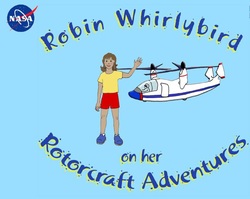
Your mission for this week is to become a rotocraft engineer!
There is more than one type of engineer. The engineer you have probably heard most about it the engineer of a train. There are many other types of engineers and they have ver important jobs. Basically, an engineer uses science and maths to create products, buildings, and structures that we build everyday. The computer you are using right now was designed and built by an engineer. The chair you are sitting on was designed and built my an engineer. The soap you used to wash your hands before lunch was tested and designed by an engineer. If you have any type of processed food for lunch (like something from a boxed mix) it was probably designed by an engineer. The water pipes and sewer lines that run through your house and through your town were designed by engineers. There are MANY types of engineering and many ways engineering impacts our life everyday.
The first part of the mission is to learn more about rotocraft before we can design and build a model of one ourselves.
Ask your Science Buddy to help you read Robin Whirlybird on her Rotocraft Adventures. You will learn about different types of rotocraft and how they work.
Go to Build a Rotocopter for the basic Rotocoptor design.
Now Experiment!!
Build them big and small. Build them from different types of paper. Make folds on the end of the wings to see how the flight changes. What happens when you add weight to it? Is there a difference if you make the wings longer or shorter? What happens when you make the base thinner or thicker? Is there such things as too much weight? Be careful to give yourself lots of room for your test flights! Also, think about the height of your drops. There are LOTS of things that you can change. These are called variables. Each variable change may give you a different results. You may decide that the design does not work all that well. That is great! You have learned something new and you are acting like a real scientist/engineer!
Don't forget to write up a mission report on your discoveries! Remember that each mission report is worth Brain Power Points! You can also earn points by sharing a comment about what you learned below. Don't forget to put your name and grade (like Janice (2)) so you will get credit for your points!
An extra activity if you want to learn about the forces of flight. Check out the activity How Things Fly from the National Air and Space Museum.
There is more than one type of engineer. The engineer you have probably heard most about it the engineer of a train. There are many other types of engineers and they have ver important jobs. Basically, an engineer uses science and maths to create products, buildings, and structures that we build everyday. The computer you are using right now was designed and built by an engineer. The chair you are sitting on was designed and built my an engineer. The soap you used to wash your hands before lunch was tested and designed by an engineer. If you have any type of processed food for lunch (like something from a boxed mix) it was probably designed by an engineer. The water pipes and sewer lines that run through your house and through your town were designed by engineers. There are MANY types of engineering and many ways engineering impacts our life everyday.
The first part of the mission is to learn more about rotocraft before we can design and build a model of one ourselves.
Ask your Science Buddy to help you read Robin Whirlybird on her Rotocraft Adventures. You will learn about different types of rotocraft and how they work.
Go to Build a Rotocopter for the basic Rotocoptor design.
Now Experiment!!
Build them big and small. Build them from different types of paper. Make folds on the end of the wings to see how the flight changes. What happens when you add weight to it? Is there a difference if you make the wings longer or shorter? What happens when you make the base thinner or thicker? Is there such things as too much weight? Be careful to give yourself lots of room for your test flights! Also, think about the height of your drops. There are LOTS of things that you can change. These are called variables. Each variable change may give you a different results. You may decide that the design does not work all that well. That is great! You have learned something new and you are acting like a real scientist/engineer!
Don't forget to write up a mission report on your discoveries! Remember that each mission report is worth Brain Power Points! You can also earn points by sharing a comment about what you learned below. Don't forget to put your name and grade (like Janice (2)) so you will get credit for your points!
An extra activity if you want to learn about the forces of flight. Check out the activity How Things Fly from the National Air and Space Museum.
 RSS Feed
RSS Feed
